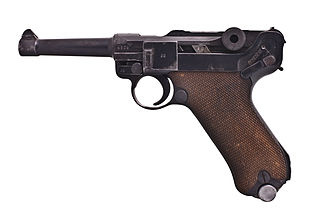
The Pistole Parabellum or Parabellum-Pistole, commonly known as just the Luger or Luger P08, is a toggle-locked recoil-operated semi-automatic pistol. The Luger was produced in several models and by several nations from 1898 to 1949.

The Thompson submachine gun is a blowback-operated, selective-fire submachine gun, invented and developed by Brigadier General John T. Thompson, a United States Army officer, in 1918. It was designed to break the stalemate of trench warfare of World War I, although early models did not arrive in time for actual combat.
A semi-automatic firearm, also called a self-loading or autoloading firearm, is a repeating firearm whose action mechanism automatically loads a following round of cartridge into the chamber and prepares it for subsequent firing, but requires the shooter to manually actuate the trigger in order to discharge each shot. Typically, this involves the weapon's action utilizing the excess energy released during the preceding shot to unlock and move the bolt, extracting and ejecting the spent cartridge case from the chamber, re-cocking the firing mechanism, and loading a new cartridge into the firing chamber, all without input from the user. To fire again, however, the user must actively release the trigger, and allow it to "reset", before pulling the trigger again to fire off the next round. As a result, each trigger pull only discharges a single round from a semi-automatic weapon, as opposed to a fully automatic weapon, which will shoot continuously as long as the ammunition is replete and the trigger is kept depressed.

The Mauser C96 is a semi-automatic pistol that was originally produced by German arms manufacturer Mauser from 1896 to 1937. Unlicensed copies of the gun were also manufactured in Spain and China in the first half of the 20th century.

A semi-automatic pistol is a handgun that automatically ejects and loads cartridges in its chamber after every shot fired. Only one round of ammunition is fired each time the trigger is pulled, as the pistol's fire control group disconnects the trigger mechanism from the firing pin/striker until the trigger has been released and reset.

The 9×23mm Largo centerfire pistol cartridge was developed in 1901 for the Bergmann Mars pistol.

The Karabinek wz.29 was a Polish bolt-action short rifle based on the German Kar98AZ. Identifying attributes include a 98/05 style mast bayonet lug ending directly beneath the front sight and winged protective ears to either side of the front sight blade. Cavalry models featured a turned-down bolt handle, and early versions had a stacking hook near the end of the stock on the right side.
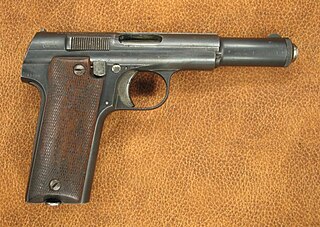
The Astra 600 is a Spanish semi-automatic pistol that was used during World War II by the Wehrmacht. Designed by Unceta y Cia, it was a shortened version of the Astra 400 manufactured to fire 9×19mm Parabellum, which was the standard pistol ammunition for Germany at the time. The Astra 600 was designated the Pistole Astra 600/43 when used by the German Military during World War II. Approximately 59,400 Astra 600s were manufactured before production ceased.

The FN Model 1910 is a blowback-operated, semi-automatic pistol designed by John Browning and manufactured by Fabrique Nationale of Belgium.

Star Bonifacio Echeverria, S.A. was a manufacturer of small arms in the Basque region of Spain from about 1905 until 1997.

The FN Model 1903, or Browning No.2 is a semi-automatic pistol designed by John Browning and manufactured by Belgian arms manufacturer Fabrique Nationale (FN). It was introduced in 1903 and fired the 9×20mmSR Browning Long cartridge. It should not be confused with the US-made Colt Model 1903 Pocket Hammerless, nor with the Colt Model 1903 Pocket Hammer. The FN Model 1903 is based on the same mechanical design as the Colt Model 1903 Pocket Hammerless, which Browning sold to both companies, but enlarged to handle the more powerful 9mm Browning Long cartridge. The M1903's reliability, accuracy, light weight, and quick reloading made it a popular service pistol for many police forces and militaries. The pistol was initially introduced by FN as the Browning Modèle de Guerre or Browning Grand Modèle.

The Rubypistol was a semi-automatic pistol of .32 ACP calibre made by Gabilondo y Urresti and other Spanish companies. It saw use in both World Wars as the service weapon of the French Army under the name Pistolet Automatique de 7 millim.65 genre "Ruby".

Astra Unceta y Cía was a Spanish weapons manufacturer founded on July 17, 1908, under the name Esperanza y Unceta by Juan Esperanza and Pedro Unceta. Initially based in Eibar, the centre of the Basque arms industry, the company moved in 1913 to Guernica.
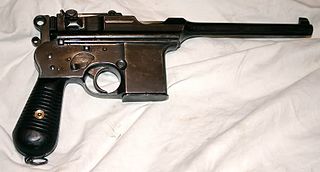
The Astra Model 900 is one of many Spanish copies of the German Mauser C96 semi-automatic pistol. It shares the same caliber, magazine capacity, and holster type and is generally very similar to the German handgun.

The Astra A-100 is a Spanish double-action/single-action semi-automatic pistol that was manufactured by Astra-Unceta y Cia SA beginning in 1990. It was distributed in the United States by European American Armory (EAA). The A-100 is also known as the "Panther" as imported into the United States by Springfield Armory, and some specimens have this roll-marked on the left of the slide. The A-100 design is a further development of Astra's earlier A-80 and A-90 models. The A-80 was originally patterned after the SIG P220.
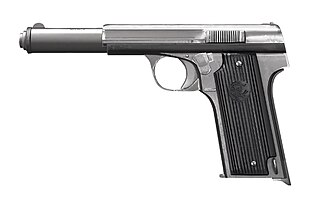
The Astra modelo 400 was a Spanish service pistol produced by weapons manufacturer Astra-Unceta y Cia SA as a replacement for the Campo-Giro 1913/1916, which had also been chambered in 9mm Largo. It was the standard issue sidearm in the Spanish Army during the Spanish Civil War and also saw service in Germany during World War II.

The Bergmann–Bayard was a German-designed semi-automatic pistol produced under license in Belgium.
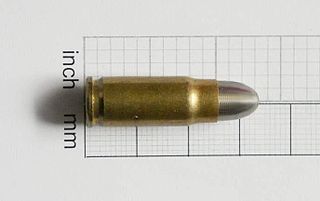
The 7.63×25mm Mauser round is a bottleneck, rimless, centerfire cartridge, originally developed for the Mauser C96 service pistol. This cartridge headspaces on the shoulder of the case. It later served as the basis for the 7.62mm Tokarev cartridge commonly used in Soviet and Eastern Bloc weapons.

















